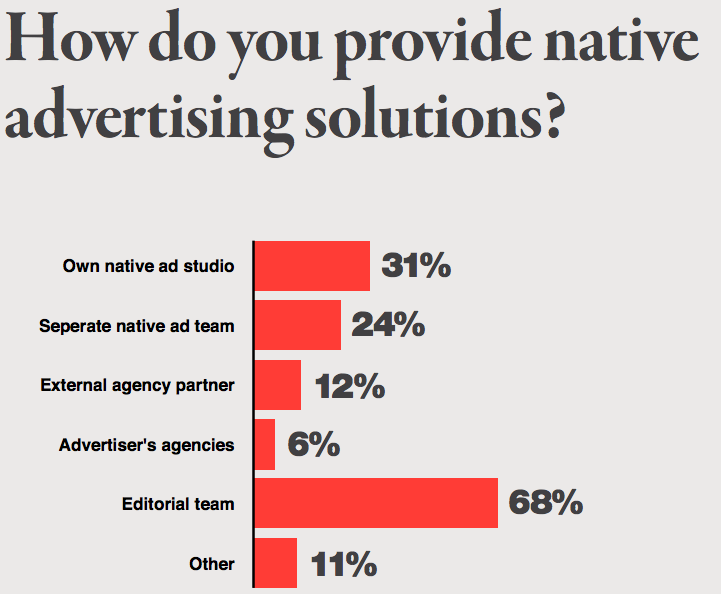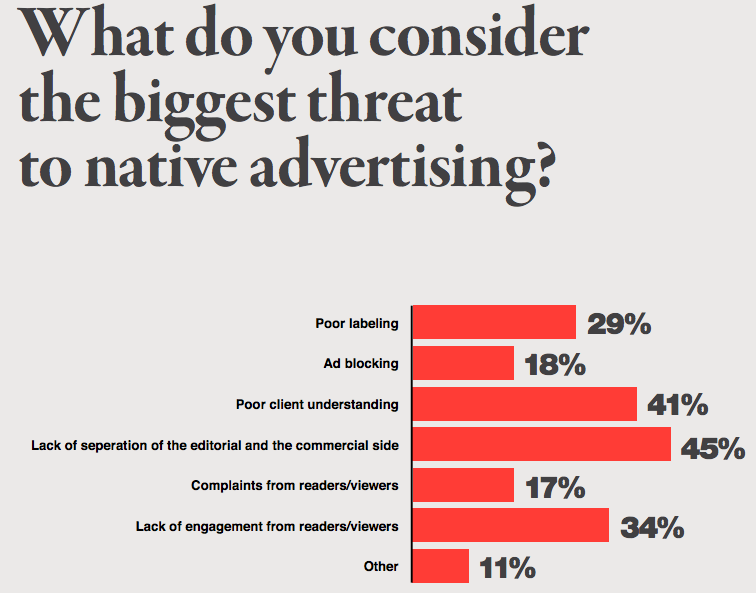Media
Study: 68% of Publishers Use Editorial Staff to Create Native Ads
If you’re on the editorial staff of a media company, odds are you’re creating native advertising—or someone on your team is.
According to a new survey of 140 magazine media executives in 39 countries, publishers are increasingly investing in native advertising—and they’re increasingly creating it themselves. The survey was done by the Native Advertising Institute (NAI), an association meant to help raise the quality of native advertising; and FIPP, a media trade organization.
According to the respondents, who remained anonymous for the study, 68 percent use editorial staff to create native advertising—a whopping 37 percent more than the closest alternative, native ad studios owned by the publisher.

If we take these stats as representative of the entire media landscape, this means that a majority of journalists are part-time copywriters. At the very least, it seems likely that many more editorial teams are involved in native advertising than is commonly believed.
For those who believe in the traditional journalism tenet of the separation of “church and state,” meaning that sales and editorial shouldn’t mix, that’s a problem. Conflicts of interest abound, and audiences may feel deceived if they know that a reporter is also creating advertising content.
But separation of editorial and sales is no longer as sacred as it once was. Condé Nast, Hearst, The Daily Mail, The Guardian, and other publishers use editorial staffers to help create native advertising. A 2013 quote from Time Inc.’s CEO, Joseph Ripp, says a lot about the current state of church and state: “We believe effective collaboration across business and editorial lines is imperative if we are to succeed as an independent company.”
Even The New York Times, which strongly stands by the separation of its T Brand Studio from its editorial staff, has started to create cracks in the wall.
Ironically, though, media executives readily admit that using editorial staff to create native advertising is problematic. According to respondents, the biggest threat to native advertising, at 45 percent, is “lack of separation of the editorial and the commercial side.”
Poor labeling was also seen as a significant threat, at 29 percent; 11 percent say they don’t label at all, despite the potential for legal recourse.

Lack of disclosure also erodes readers’ trust in a publication, and causes an increase in ad blockers. And the NAI’s study doesn’t take account that having a label doesn’t mean that the publication follows best practices. A Contently study last year found that most consumers struggled to distinguish native ads from articles.
Another recent study conducted by the Online Trust Alliance (OTA) gave 71 of the top 100 news publishers a failing grade when it came to disclosing their native advertising. The more that publishers rely on poorly labeled native advertising, the more they erode trust, and the less valuable native advertising becomes.
In other words, publishers have found themselves in a sinister cycle, and editorial staffers have no choice but to go along for the ride.
Image by Albasir Canizares/EyeEm/Getty ImagesGet better at your job right now.
Read our monthly newsletter to master content marketing. It’s made for marketers, creators, and everyone in between.




